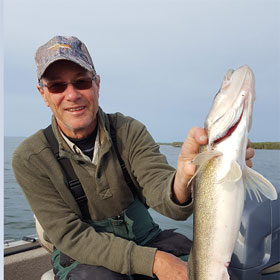Minnesota Muskie Lure Shopping Made Easy
By C.B. Bylander
Oct 11, 2019
Muskellunge lures come in many different sizes, styles and colors, and the most popular lures can be pricey. Read this blog to save some money!
Modern sports stores feature aisle after aisle of fishing lures and the abundance can be intimidating.
This is particularly true for those getting into muskellunge fishing. Muskellunge lures come in many different sizes, styles and colors, and the most popular lures often cost more than $25. As a result, it is easy to spend $100 and have but three or four lures to show for it.
So, what lures should you buy if you want to start muskellunge fishing?
My suggestion is to keep it simple. Do this by selecting a single lure from each of four popular lure categories. This is an economical way to fill your tackle box with a variety of lures. As you add to your collection make sure to have both medium and large lures and bright and natural colors. Don’t miss our ‘should know’ on Muskie fishing in Minnesota.
Spinnerbait
A large spinnerbait is a great lure because it creates flash and vibration that attract prey-seeking muskellunge. A spinnerbait features shiny metal blades that spin like a propeller when the lure is reeled through the water. Spinnerbaits come in two main types: “in-line” and “safety pin," the former because of its linear look and the latter due to its safety pin shape. A spinnerbait is easy to cast and can be trolled too. A safety pin spinnerbait with a single up-turned hook is ideal for casting over and into weedbeds because it is almost weedless. Many muskellunge anglers still fish with the classic bucktail spinner while others prefer those with marabou or tinsel skirting.
Topwater Bait
A topwater bait is a surface lure. It attracts fish by creating a commotion on the surface. Some lures have propellers. Some have tail sections that rotate and splash. Some are designed to replicate a dying or injured fish when jerked or popped through the water. The three main types of topwater lures are walk-the-dog baits, prop baits, and creeper baits. Topwater lures are fun to fish, in part, because strikes at the surface are a blast to behold. They are particularly fun to fish in calm shallow water.
Crankbait
Crankbaits are another go-to choice for muskellunge anglers because they mimic large baitfish. Crankbaits come in many shapes and sizes but are basically a hard-bodied lure – with or without a diving lip – that wobbles in a natural-looking way when retrieved. Crankbaits are good choice for fishing over rocky structure or along weed edges. Crankbaits can be trolled, too, making them a good option when you want to cover a lot of water in a short time.
Rubberbait
Rubber baits and soft plastic baits are increasingly popular for fishing deep water. These sinking lures, some of which weigh up to three-quarters of a pound, often feature long serpentine tails. Rubberbaits can be fished in a variety of ways. Some anglers prefer a straight retrieve. Some reel-in with a pull-pause-pull technique, which mimics a dying baitfish as it rises and falls. Others like to vertical jig these big lures. As with other lures, experiment with your retrieves and determine what works for you and the fish.
These days many muskellunge anglers have dozens upon dozens of lures. Still, you can do well with far fewer. If you own one or two of each of these types of baits you are likely in good shape for most muskellunge waters. They are prefect companions to a stout rod with a bait-casting reel, heavy braided line of 50-pound test or more and a foot-long steel or fluorocarbon leader between your line and your lure. You will need a leader because muskellunge have razor sharp teeth that can easily slice through your line.









